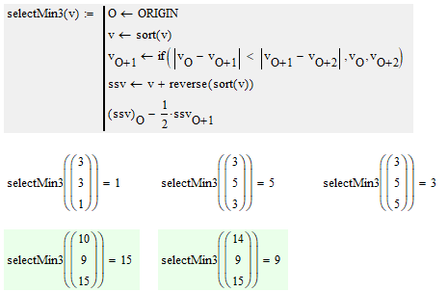- Subscribe to RSS Feed
- Mark Topic as New
- Mark Topic as Read
- Float this Topic for Current User
- Bookmark
- Subscribe
- Mute
- Printer Friendly Page
SELECT DIFFERENT
- Mark as New
- Bookmark
- Subscribe
- Mute
- Subscribe to RSS Feed
- Permalink
- Notify Moderator
- Labels:
-
Mathcad Usage
Accepted Solutions
- Mark as New
- Bookmark
- Subscribe
- Mute
- Subscribe to RSS Feed
- Permalink
- Notify Moderator
Here is a utility function. The input is a vector of scalar values of any length. The return value is that vector element which occurs least often. If there are several, the first one to appear is chosen.
And here is a function working just for your special case of a three element vector with one single value
- Mark as New
- Bookmark
- Subscribe
- Mute
- Subscribe to RSS Feed
- Permalink
- Notify Moderator
- Mark as New
- Bookmark
- Subscribe
- Mute
- Subscribe to RSS Feed
- Permalink
- Notify Moderator
Hi
Can this be done within a tolerance band?
If I had
I'd like to select 15 000
- Mark as New
- Bookmark
- Subscribe
- Mute
- Subscribe to RSS Feed
- Permalink
- Notify Moderator
If A[0<>A[1<>A[2 and you want max. middle or mini also can select after else instead max(A) but sort(A)[1 and min(A).
- Mark as New
- Bookmark
- Subscribe
- Mute
- Subscribe to RSS Feed
- Permalink
- Notify Moderator
I guess your approach is not what ppal is looking for. Maybe you misunderstood the intention.
If no two values are equal, not the largest value should be returned but the value which is farthest apart from the other two.
So with input 9, 14, 15 your function would return 15 while it should return 9.
- Mark as New
- Bookmark
- Subscribe
- Mute
- Subscribe to RSS Feed
- Permalink
- Notify Moderator
Thanks, I understand what he wants.
- Mark as New
- Bookmark
- Subscribe
- Mute
- Subscribe to RSS Feed
- Permalink
- Notify Moderator
Have you tested your function with a couple of triples? I guess its not doing what was demanded.
Just try the original set of (10; 9; 15).
- Mark as New
- Bookmark
- Subscribe
- Mute
- Subscribe to RSS Feed
- Permalink
- Notify Moderator
- Mark as New
- Bookmark
- Subscribe
- Mute
- Subscribe to RSS Feed
- Permalink
- Notify Moderator
Try (1,2,10). Your f3 would return 2 and not 10.
I don't think that the mean is of much help in this task.
After sorting the values the only thing important is, which of the two outer elements is farther away from the center element. And thats exactly what my functions do -> https://community.ptc.com/t5/Mathcad/SELECT-DIFFERENT/m-p/830256/highlight/true#M203207
- Mark as New
- Bookmark
- Subscribe
- Mute
- Subscribe to RSS Feed
- Permalink
- Notify Moderator
Here is a modified selectMin3 (yes, well, the name was chosen misleading, you should change it).
- Mark as New
- Bookmark
- Subscribe
- Mute
- Subscribe to RSS Feed
- Permalink
- Notify Moderator
OK, with the modification done to selectMin3 the approach was unnecessary complicated.
A more straightforward approach is shown here, using just one if-else (function or statement - your choice)
- Mark as New
- Bookmark
- Subscribe
- Mute
- Subscribe to RSS Feed
- Permalink
- Notify Moderator
I am using this now. It is doing what I wanted to do. Thank you.
- Mark as New
- Bookmark
- Subscribe
- Mute
- Subscribe to RSS Feed
- Permalink
- Notify Moderator
I wonder if this simple implementation works satisfactorily:
Some results:
Success!
Luc
- Mark as New
- Bookmark
- Subscribe
- Mute
- Subscribe to RSS Feed
- Permalink
- Notify Moderator
Sophisticated! 🙂
- Mark as New
- Bookmark
- Subscribe
- Mute
- Subscribe to RSS Feed
- Permalink
- Notify Moderator
Yes! - Few roads now leading to Rome.
- Mark as New
- Bookmark
- Subscribe
- Mute
- Subscribe to RSS Feed
- Permalink
- Notify Moderator
Here is a utility function. The input is a vector of scalar values of any length. The return value is that vector element which occurs least often. If there are several, the first one to appear is chosen.
And here is a function working just for your special case of a three element vector with one single value


























